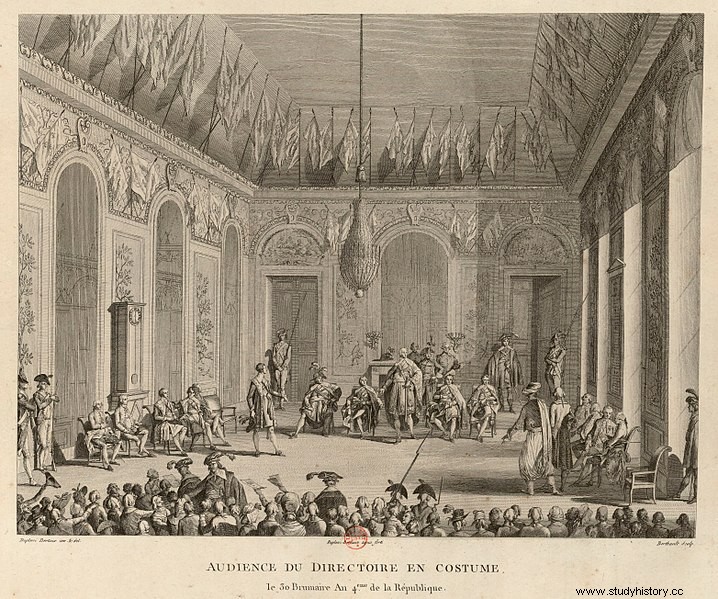The French Revolution, which began in the spring of 1789, brought about absolute monarchy. If the First Republic is ratified, it does not manage to stem the Terror which plunges France into chaos. It was not until July 1794 with the execution of Robespierre, incarnation of the Terror, that the signs of appeasement and the desire for a collegial power appeared:the Directory.
October 26, 1795 - November 9, 1799

Characters
Paul Barras
François Noël Babeuf aka Gracchus Babeuf
Napoleon Bonaparte
Lazare Carnot
Louis-Marie de La Réveillère-Lépeaux
Etienne-François Le Tourneur
Jean-Francois Reubell
Emmanuel-Joseph Sieyès
Charles-Maurice de Talleyrand
Procedure
The Terror ending, it is urgent to establish a new government. The Convention writes the Constitution of Year III. Universal male suffrage is abolished, the censitaire is restored. A Council of Five Hundred and a Council of Elders are elected to direct the legislative power. The first has the initiative of laws, free to the Elders to approve or reject. These two assemblies are renewable every three years, by thirds, and do not have ascendancy one over the other. In addition, five Directors, proposed by the Five Hundred and elected by the Elders, run the executive, hence giving name to this government. The first directors were Barras, Reubell, Carnot (who replaced Sieyès), Le Tourneur and La Réveillère-Lépeaux.
The Terror is no more. Hedonism reigns; the Thermidorian bourgeoisie, big winner of the Revolution, displays its wealth and spreads in eccentricity, especially in clothing. But this carelessness ignores the people who are starving. Inequalities are abysmal, poverty and insecurity are rampant, the assignat is collapsing and the venality of politicians persists. To get out of the financial crisis, the Directory decided to destroy the assignat on February 19, 1796 and created paper money and territorial mandates, triggering numerous oppositions. Thus, the Jacobin Gracchus Babeuf publishes the Manifesto of Equals . With the Conjuration of Equals in 1796, he led a conspiracy against the Directory but was guillotined the following year.
In addition, the Directory was constantly weakened by the royalist threat, both within the country (Vendée) and in Europe. Despite the temporary respite obtained by military victories (Treaty of Campoformio 1797), the consolidation of finances, the adoption of societal reforms (divorce), etc., power remains fragile. In 1799, a new European monarchist coalition threatened France. The conditions are ideal for a coup, organized by Sieyès, Talleyrand and carried out by Napoleon Bonaparte on November 9, 1799.
Consequences
- The Directory is a failure. The internal wars at the political level and the lack of ascendancy of one of the Councils have created deadlocks, putting the Management Board in danger from its creation. Caught between two oppositions (Jacobin and Royalist), the Directory was completely dependent on the army, which saved it on several occasions.
- The coup carried out by Napoleon Bonaparte heralds the Consulate, the antechamber of the First Empire.
